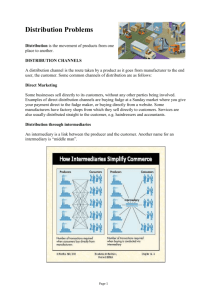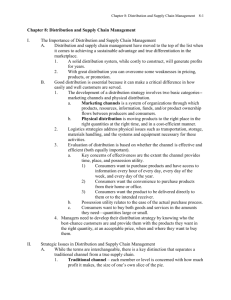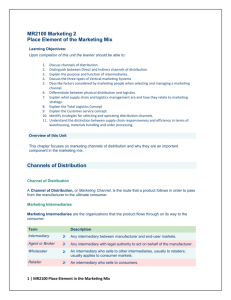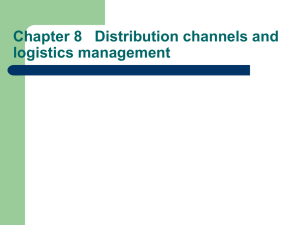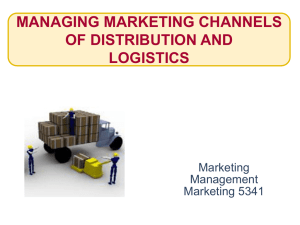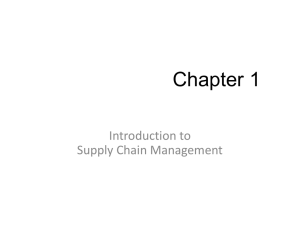Lecture 15 ItM Product distribution
advertisement
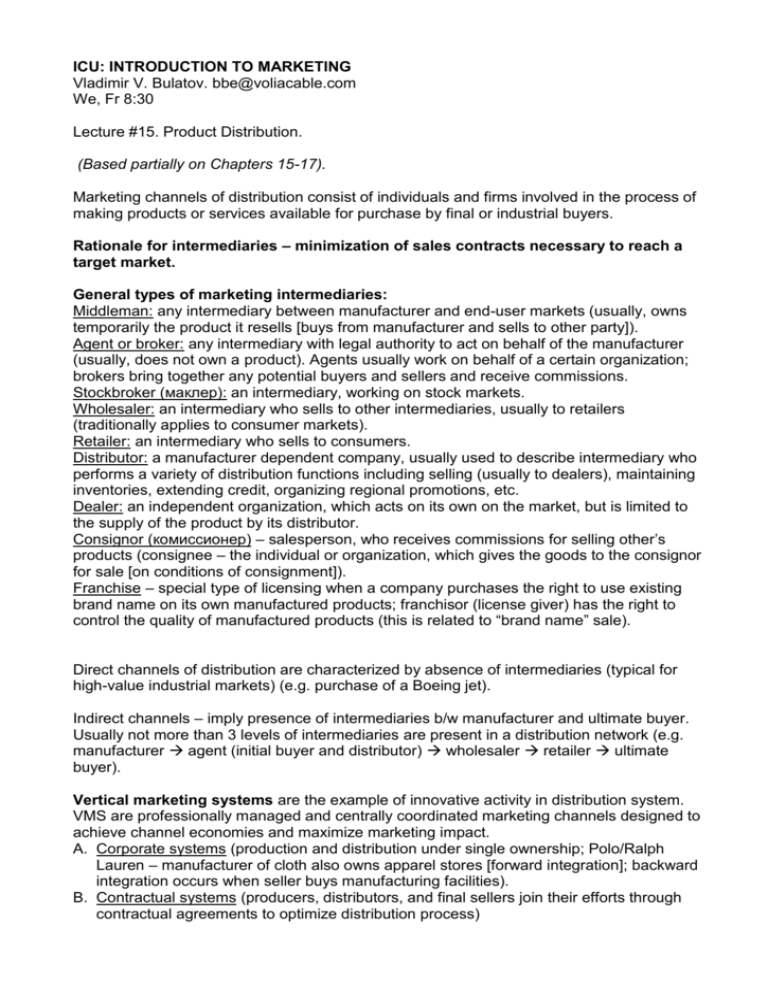
ICU: INTRODUCTION TO MARKETING
Vladimir V. Bulatov. bbe@voliacable.com
We, Fr 8:30
Lecture #15. Product Distribution.
(Based partially on Chapters 15-17).
Marketing channels of distribution consist of individuals and firms involved in the process of
making products or services available for purchase by final or industrial buyers.
Rationale for intermediaries – minimization of sales contracts necessary to reach a
target market.
General types of marketing intermediaries:
Middleman: any intermediary between manufacturer and end-user markets (usually, owns
temporarily the product it resells [buys from manufacturer and sells to other party]).
Agent or broker: any intermediary with legal authority to act on behalf of the manufacturer
(usually, does not own a product). Agents usually work on behalf of a certain organization;
brokers bring together any potential buyers and sellers and receive commissions.
Stockbroker (маклер): an intermediary, working on stock markets.
Wholesaler: an intermediary who sells to other intermediaries, usually to retailers
(traditionally applies to consumer markets).
Retailer: an intermediary who sells to consumers.
Distributor: a manufacturer dependent company, usually used to describe intermediary who
performs a variety of distribution functions including selling (usually to dealers), maintaining
inventories, extending credit, organizing regional promotions, etc.
Dealer: an independent organization, which acts on its own on the market, but is limited to
the supply of the product by its distributor.
Consignor (комиссионер) – salesperson, who receives commissions for selling other’s
products (consignee – the individual or organization, which gives the goods to the consignor
for sale [on conditions of consignment]).
Franchise – special type of licensing when a company purchases the right to use existing
brand name on its own manufactured products; franchisor (license giver) has the right to
control the quality of manufactured products (this is related to “brand name” sale).
Direct channels of distribution are characterized by absence of intermediaries (typical for
high-value industrial markets) (e.g. purchase of a Boeing jet).
Indirect channels – imply presence of intermediaries b/w manufacturer and ultimate buyer.
Usually not more than 3 levels of intermediaries are present in a distribution network (e.g.
manufacturer agent (initial buyer and distributor) wholesaler retailer ultimate
buyer).
Vertical marketing systems are the example of innovative activity in distribution system.
VMS are professionally managed and centrally coordinated marketing channels designed to
achieve channel economies and maximize marketing impact.
A. Corporate systems (production and distribution under single ownership; Polo/Ralph
Lauren – manufacturer of cloth also owns apparel stores [forward integration]; backward
integration occurs when seller buys manufacturing facilities).
B. Contractual systems (producers, distributors, and final sellers join their efforts through
contractual agreements to optimize distribution process)
1. Wholesaler-sponsored voluntary chains (when a big wholesaler joins different retailers
to practice economies of scale);
2. Retailer-sponsored voluntary chains (when a group of retailers join efforts to act as a
single entity and deal with volumes, typical for wholesalers);
3. Franchising.
a. Manufacturer-sponsored retail franchise system (Ford and its franchisee sellers);
b. Manufacturer-sponsored wholesale franchise system (Coca-Cola – sells
concentrate to franchisee-wholesalers all over the world, which then promote it
regionally);
c. Service-sponsored retail franchise system (McDonald’s).
C. Administered Systems (where coordination of production and distribution is achieved
through influence of one actor in the network). (e.g. P&G as a manufacturer, Sears as a
seller, etc.)
When choosing distribution channel the following factors are to be considered:
1. Environmental factors (e.g. appearance of new transportation means, employment rate
[which may case a shift from personal sales to direct {through catalogues}], etc.)
2. Consumer factors (who, what, when, how [etc.] purchases goods; assessment of these
characteristics conditions the choice of the right distribution channel).
3. Product factors (e.g. printing presses are sold through personal sales, candy – through
retail stores and vending machines, etc.; also product stage in life cycle affects marketing
channel).
4. Company factors (firm’s financial, human, and technological capabilities).
Channel design considerations:
1. Target market coverage:
a. Intensive distribution (basic goods like chewing gum);
b. Exclusive distribution (distribution through specified outlets [e.g. one certain dealer]);
c. Selective distribution (compromise between the previous two approaches; usually
used for expensive/prestigious goods).
2. Satisfying buyer requirements (which are: information, convenience, variety, attendant
services [delivery, installation, etc.])
3. Profitability (distribution costs are critical for any manufacturer).
____________
Physical distribution and Logistics management.
Physical distribution management is organizing the storage and movement of finished
products to customers.
Logistics management is organizing the cost-effective flow of raw materials, in-process
inventory, finished goods, and related information from the point-of-origin to the point-ofconsumption.
Logistics deals directly with physical supply (inbound movement of goods from
supplier to the firm) and physical distribution (outbound movement of goods from the
firm to the customer).
Importance of logistics is reflected by the fact that a merchandise company might have 54000
separate deliverable items (L.L. Bean).
In US logistics costs in 1991 accounted to $587 billion (which is 10.3% of GNP). (Imagine
what kind of business is run by such a company as MAERSK?).
Logistics has a significant impact on 4P (imagine, after a well-run AD campaign, products
do not appear on the shelves because they were spoiled while transported).
Product factors: shelf life (consider fruits or newspapers), package, etc.)
Pricing factors: geographical pricing, quantity discounts (since large quantities generate lower
unit price due to transportation optimization).
Place factors: (what is the logistics then for?)
Promotion factors: logistics and promotion activities must be coordinated to guarantee goods
in proper places on time.
Total Logistics Cost Concept:
Warehousing and material handling.
Storage warehouses: designed to store goods for either definite or indefinite period of time
(e.g. wine cellars; household goods warehouses; etc.)
Distribution warehouses: designed to facilitate timely movement of goods; these places allow
firms to hold their stock in decentralized locations. They are also used to facilitate sorting and
consolidating products from different plants or different suppliers.
Material handling involves moving goods over short distances into, within, and out of
warehouses and manufacturing plants. Involves the highest risk of product damage.
Order processing and inventory management consumes the highest portion of logistics
efforts. The core idea of this activity is balancing inventory to have optimum level of customer
satisfaction.
Amount of goods demanded may vary, and optimizing the pace of filling warehouses may be
a difficult task. Too little products in the storage place may result in excessive spending, too
much – may cause a significant number of missed customers.
Inventory costs consist of the following:
1. Capital costs: tied up funds in unsold inventory.
2. Inventory service costs: e.g. insurance costs.
3. Storage costs: warehousing space and material handling.
4. Risk costs: possible loss, damage, pilferage, perishability, obsolescence.
<JIT concept>
Retailing. (Includes all activities involved in selling, renting, and providing goods and
services to ultimate consumers for personal, family, or household use).
Form of ownership of retailers.
1. Independent retailer (run by independent individual).
2. Corporate Chain (multiple outlets under common ownership; one corporation may have
several differently or similarly named stores, selling a great variety of items [e.g. ECCO
brand, sold through different stores, run by one company]; in US: Sears, Wal-Mart, Kmart,
etc).
3. Contractual system (involves independently owned stores that band together to act like a
chain – precisely the ones, described in VMS:
- retailer-sponsored cooperatives;
- wholesaler-sponsored voluntary chains;
- franchises.
Level of service that is usually offered by retail stores:
- self-service (supermarket);
- limited service (may include such services as telephone ordering, merchandise return,
etc.);
- full-service (which has twice more salespeople, offer delivery of goods to homes,
extensive consultations, etc.)
There exist a competition on the market of offering retail services to customers. A retail store
must be positioned on the market to be distinct from other retailers.
In your book a matrix with the following characteristics is assessed (according to MAC Group
Inc. Model):
- breadth of product line (narrow broad)
- value added (high low).
<Chart 18-7. Other criteria can also be chosen to position retail outlets on the market>.

